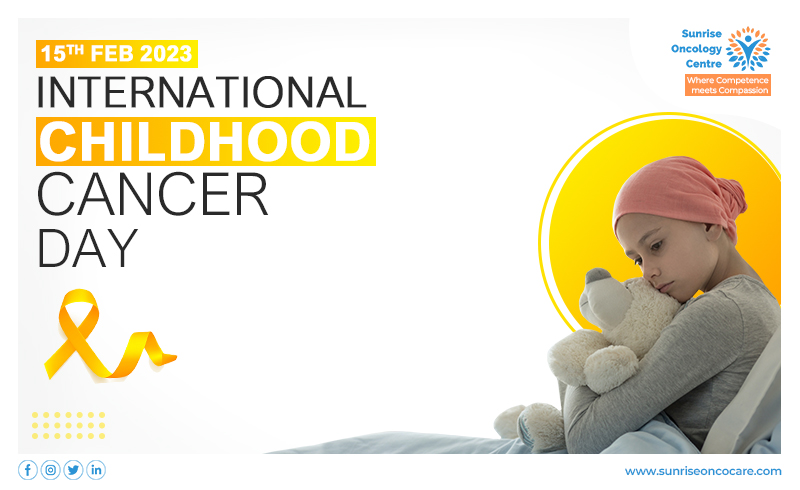Every year on February 15, the world comes together to commemorate International Childhood Cancer Day (ICCD), a movement that was started to increase public awareness of childhood cancer and show support for children and teenagers who have the disease, their survivors, and their families. The WHO Global Childhood Cancer Initiative’s target goal is to end all pain and suffering experienced by children battling cancer and to achieve a minimum 60% survival rate for all children worldwide by 2030. Over the following ten years, this will likely result in an extra one million children’s lives being saved, about tripling the current cure rate.1
The day is a reminder that childhood cancer is a global issue that requires continued support and action2
Around the world, cancer is one of the main causes of death for kids and teenagers. Globally, more than 400,000 kids receive cancer diagnoses every year. However, the majority of these deaths might be avoided with early detection and access to efficient care. Therefore, it is crucial to be knowledgeable about signs and symptoms, diagnosis, available treatments, and prevention methods.2
The group of cancers that develop between birth and the age of 19 is known as childhood cancer. However, it should be emphasized that various nations have their own acceptable ages for childhood cancer. Fundamentally speaking, all cancers, including childhood cancers, are characterized by the fast growth of abnormal cells that have genetic defects.3
Cancerous cells in children, however, differ from cancers in adults. Childhood cancers often start in growing organs and tissues, grow quickly over a few weeks to months, and spread across the body in different ways than adult malignancies, which typically occur in mature tissues. They frequently resemble other children’s illnesses like infection due to their rapid development, which means they may have few or mild symptoms and cause the kid to become dangerously unwell soon.3
What are the types of childhood cancers?4
Children tend to develop cancers that are distinct from those that affect adults. The most typical cancers in children are:
- Leukemia
- Brain and spinal cord tumors
- Neuroblastoma
- Wilms tumor
- Lymphoma (Hodgkin and non-Hodgkin)
- Rhabdomyosarcoma
- Retinoblastoma
- Bone cancer (osteosarcoma and Ewing sarcoma)
Observing the signs and symptoms:5
Cancer in children can be challenging to find. Many of the signs and symptoms listed are similar to typical pediatric diseases and can occur in children with cancer.Children with cancer may occasionally show neither symptoms nor indicators. Or, a medical disease other than cancer may be to blame for a symptom or sign’s occurrence.
Many of the symptoms can be described using an acronym (CHILDCANCER):
- Continued, unexplained weight loss
- Headaches, often with early morning vomiting
- Increased swelling or persistent pain in the bones, joints, back, or legs
- Lump, especially in the abdomen, neck, chest, pelvis, or armpits
- Development of excessive bruising, bleeding, or rash
- Constant, frequent, or persistent infections
- A whitish color behind the pupil
- Nausea
- Constant tiredness
- Eye or vision changes
- Recurring or persistent fevers of unknown origin
Treatment for childhood cancers6
Cancer in children is uncommon in general. This suggests that it could be difficult for medical professionals to develop treatments if they are uninformed of what has been successful for other children. Some of the below-listed therapy methods are utilized.
- Surgery
Surgery is the removal during an operation of the tumor, whether it is malignant or not, along with a tiny portion of the surrounding healthy tissue.
- Cancer Medications
Medication to kill cancer cells might be part of the therapeutic strategy. To treat cancer cells locally or across the body, medication can be injected into the bloodstream.
The types of the strategy used for childhood cancer include:
- Chemotherapy
- Immunotherapy
- Radiation therapy
In radiation therapy, high-energy x-rays or other particles—like photons or protons—are utilized to destroy cancer cells. Because healthy organs and tissues in the radiation field are prone to damage and secondary cancers, especially in young children when possible, doctors typically attempt to minimize or reduce the use of radiation treatment in this age range.
- Bone marrow transplantation/stem cell transplantation
A bone marrow transplant is a medical procedure in which bone marrow that contains the cancer is replaced by highly specialized cells
Can Childhood Cancers Be Prevented?7,8
The likelihood of a kid developing cancer is not influenced by lifestyle-related factors in cases of childhood cancer. Rarely, a kid may inherit gene alterations that greatly increase their risk of developing a particular type of cancer. In these situations, medical professionals may occasionally advise performing preventative surgery to remove an organ before cancer has a chance to spread there.
Promoting Habits That Could Reduce Cancer Risk:
- Get enough folic acid during pregnancy.
- Get enough physical activity during childhood.
- Ensuring safe, stable, nurturing relationships and environments for all children and families.
- Avoid alcohol and tobacco use during pregnancy.
- Keep children away from second-hand smoke and traffic-related air pollution.
- Avoid exposure to chemicals and radiation that can cause cancer.
In conclusion, International Childhood Cancer Day is a significant chance to increase public awareness of the effects of childhood cancer and the need for ongoing assistance for afflicted children and families. Everyone can contribute to the battle against children’s cancer, whether it is by increasing awareness, enhancing access to care, or promoting research.
References:
- International Childhood Cancer Day, Available at: https://internationalchildhoodcancerday.org/ Last accessed on 3rd February 2023.
- International Childhood Cancer Day 2021, Available at: https://www.paho.org/en/campaigns/international-childhood-cancer-day-2021 Last accessed on 3rd February 2023.
- CureAll Framework: WHO Global Initiative for Childhood Cancer, Available at: https://cdn.who.int/media/docs/default-source/documents/health-topics/cancer/cureall-framework-who-global-initiative-for-childhood-cancer-pamphlet.pdf?sfvrsn=6e9c5b1b_8 Last accessed on 3rd February 2023.
- Introduction to childhood cancer, Available at:https://www.indiancancersociety.org/cancer-information/childhood-cancer.aspx Last accessed on 3rd February 2023.
- Childhood Cancer: Symptoms and Signs, Available at: https://www.cancer.net/cancer-types/childhood-cancer/symptoms-and-signsLast accessed on 3rd February 2023.
- Childhood Cancer Guide, Available at: https://www.cancer.net/cancer-types/childhood-cancer last accessed on 27th January 2023.
- Can Childhood Cancer be Prevented? Available at:https://www.cancer.org/cancer/cancer-in-children/preventing-childhood-cancers.html Last accessed on 3rd February 2023.
- Cancer Prevention During Early Life, Available at: https://www.cdc.gov/cancer/dcpc/prevention/childhood.htm#:~:text=Keeping%20children%20away%20from%20secondhand,CT%20(computed%20tomography)%20scans. Last accessed on 3rd February 2023.

